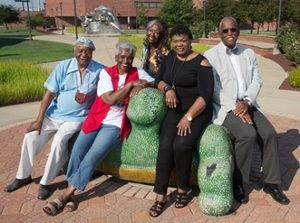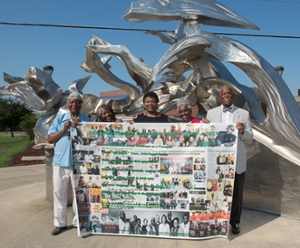Image may be NSFW.
Clik here to view. The East St. Louis 1917 Centennial Commission and Cultural Initiative (CCCI) is undertaking crucial work to help heal historical wounds, celebrate survival and advance the town’s quality of life, according to Southern Illinois University Edwardsville alumni and faculty, who serve as CCCI commissioners.
The East St. Louis 1917 Centennial Commission and Cultural Initiative (CCCI) is undertaking crucial work to help heal historical wounds, celebrate survival and advance the town’s quality of life, according to Southern Illinois University Edwardsville alumni and faculty, who serve as CCCI commissioners.
This year marked the 100th anniversary of the 1917 Race Riots in East St. Louis, and news of CCCI’s efforts is “rippling throughout the world,” said Eugene B. Redmond, SIUE emeritus professor in the Department of English Language and Literature, and Poet Laureate of East St. Louis.
“What’s happening is what we as a Commission wanted to happen,” he said. “In 1917, East St. Louis was the center of global attention, and in 2017, it is getting the same widespread attention.”
The centennial year began with a commemorative program hosted at Forest Park Community College in January. Saint Louis University spearheaded an educational conference from May 26-28. During the formal programming from June 30-July 2, the Commission observed the lowering of the St. Clair County flag to half-mast in a ceremony at the courthouse; blessing the site of the first monument in honor of the victors and victims; a cultural/artistic salute and the silent march to Eads Bridge culminating with the laying of the wreath.
Image may be NSFW.
Clik here to view. Additional events and observances will be offered in September and throughout the year. Times, dates and locations will be disclosed later. The non-profit CCCI also has plans to help establish a historical society and history museum in East St. Louis.
Additional events and observances will be offered in September and throughout the year. Times, dates and locations will be disclosed later. The non-profit CCCI also has plans to help establish a historical society and history museum in East St. Louis.
“Our work as a Commission is critical, because the earth has a memory,” said Darlene (Duncan) Swanson Roy, 2017 Golden Graduate who earned a bachelor’s in sociology/psychology from SIUE in 1967. She is president of the Eugene B. Redmond Writers Club, and author and associate editor of Drumvoices Revue, an annual anthology formerly published by the Club and SIUE.
“In East St. Louis, we are living on a wounded plain, and many people don’t know it,” Roy said. “The violence, rape and murder of 1917 soiled the soil.”
“Yes, and giving Earth the blues …,” bemoans Redmond, quoting a line from one of his multitude of poems.
“In order to heal, you have to know you’ve been hurt and get the right medication,” Roy continues. “We (humans) have to come up with a unilateral way to live together, in order for all of us to prosper.”
“As commissioners, we are unfortunately addressing an important issue which history books and oral histories have failed to emphasize,” said retired Circuit Judge Milton Wharton, an SIUE alum. Wharton earned a bachelor’s in business administration/management in 1969, was named to the SIUE Hall of Fame in 2010, served as a member of the SIUE Foundation Board of Directors, is a past-president of the SIUE Alumni Association Board of Directors and was named the SIUE Distinguished Alumnus of the Year in 1998.
“The event was so horrible in magnitude, that many blacks and whites engaged in a conspiracy of silence – wishing not to remember the event and tragically not informing their descendants,” Wharton continued. “By doing so, the education that might have come from an earnest evaluation of the events and attitudes that contributed to the holocaust, did not occur.”
CCCI commissioners emphasize that the East St. Louis “race riots” are referred to as a “pogrom.”
“It was never a race riot,” Roy said. “A ‘race riot’ means someone was feeling thwarted and was pushing back. This was about race in that blacks were holding jobs that whites felt were legitimately theirs, and those jobs were not even high paying ones.”
Redmond, Roy and Wharton are three of 20 CCCI commissioners. Other alumni and/or representatives include:
- Andrew Theising, PhD, associate professor and chair of the Department of Political Science
- Edna Patterson-Petty, who earned a master’s in art therapy in 1988, a bachelor’s in art and design in 1984, and is a noted multimedia and fabric artist, and art therapist
- Anne Walker, who achieved a bachelor’s in communications and theater in 1973. She is director of Freedom Trails, Legacies of Hope and is the former executive director of the Katherine Dunham Museum.
SIUE and African Americans in the Metro East have a long history and relationship. “It started in 1957 when the City of East St. Louis gave SIUE East St. Louis Senior High School to hold classes,” said Redmond, who began classes at SIUE in 1957. “If it hadn’t been for SIUE, many blacks would not have had degrees, because we could not afford to go away to college.”
Many SIUE alumni are working with the CCCI toward the goal of revitalization in East St. Louis. “The work of the Commission will draw attention back to East St. Louis and cause a renaissance of the town,” said Roy. “We will see a resurgence of people coming back to live, work and engage in regrowth and the redevelopment of East St. Louis.”
Photos:
SIUE Centennial Commission and Cultural Initiative Commissioners are pictured at the East St. Louis Higher Education Campus on the sculpture artwork of Edna Patterson-Petty. From L-R are: Dr. Eugene B. Redmond, Edna Patterson-Petty, Anne Walker (on top), Darlene Roy and Judge Milton Wharton.
SIUE Commissioners are also seen holding a photo and poetry collage representing the work of the East St. Louis 1917 Centennial Commission & Cultural Initiative, photographed and made by Dr. Eugene B. Redmond. Shown from L-R: Redmond, Walker, Roy, Patterson-Petty and Wharton.
Image may be NSFW.Clik here to view.